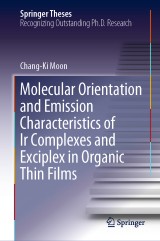Details

Molecular Orientation and Emission Characteristics of Ir Complexes and Exciplex in Organic Thin Films
Springer Theses
|
139,09 € |
|
| Verlag: | Springer |
| Format: | |
| Veröffentl.: | 29.01.2019 |
| ISBN/EAN: | 9789811360558 |
| Sprache: | englisch |
Dieses eBook enthält ein Wasserzeichen.
Beschreibungen
<p></p><p>This thesis considers molecular orientation in thin films and introduces an optical model describing this orientation as applied to organic light-emitting diodes (OLEDs). It also describes the electronic structure of intermolecular charge transfer excitons correlated to molecular orientation in solids.</p><p>It has long been known that molecular orientation influences the electrical and optical properties of molecular films. One notable example is in liquid crystals where rigid rod or disk shaped molecules are commonly used. Understanding the origin of the molecular orientation and its control by surface treatment and electric field resulted in the development of liquid crystal displays. The same thing has happened in organic electronics, and considerable effort has been devoted to understanding and controlling molecular orientation in solid films to improve charge carrier mobility and light absorption, ultimately to improve the performance of organic solar cells and thin film transistors.<br></p><p>In contrast, less attention has been paid to molecular orientation and its influence on the characteristics of OLEDs, probably because of the use of amorphous films rather than micro-crystalline films, and it is only in recent years that some molecular films are known to have preferred orientation. This thesis addresses this topic, focusing on OLEDs, describing the origin and control of the orientation of phosphorescent Ir complexes possessing spherical shape rather than rod or disk shape, the simulation of the optical characteristics of OLEDs influenced by preferred molecular orientation, and finally the orientation of intermolecular charge transfer excitons and its correlation to electronic structures in thin films.<br></p><br><p></p>
<p>List of Tables.- List of Figures.- Chapter 1. Introduction.- Chapter 2. Modeling of the dipole radiation in an anisotropic microcavity.- Chapter 3. The orientation of Ir complexes doped in organic amorphous layers.- Chapter 4. Analysis of the electronic structure and emission process of exciplex in solids.- Chapter 5. Summary and conclusion.- Bibliography.- List of Publications.- List of Presentations.- List of Patents.</p><div><br></div>
<p>Dr. Chang-Ki Moon received the "Best PhD Theses Award in 2017" in the Materials Science and Engineering department at SNU in December 2017, and the “Best Paper Award” of Schrodinger’s 2017 Excellence in Materials Science Applications Publication Contest in Schrodinger Inc. in February 15, 2018. </p>
<p>This thesis considers molecular orientation in thin films and introduces an optical model describing this orientation as applied to organic light-emitting diodes (OLEDs). It also describes the electronic structure of intermolecular charge transfer excitons correlated to molecular orientation in solids.</p><p>It has long been known that molecular orientation influences the electrical and optical properties of molecular films. One notable example is in liquid crystals where rigid rod or disk shaped molecules are commonly used. Understanding the origin of the molecular orientation and its control by surface treatment and electric field resulted in the development of liquid crystal displays. The same thing has happened in organic electronics, and considerable effort has been devoted to understanding and controlling molecular orientation in solid films to improve charge carrier mobility and light absorption, ultimately to improve the performance of organic solar cells and thin film transistors.<br></p><p>In contrast, less attention has been paid to molecular orientation and its influence on the characteristics of OLEDs, probably because of the use of amorphous films rather than micro-crystalline films, and it is only in recent years that some molecular films are known to have preferred orientation. This thesis addresses this topic, focusing on OLEDs, describing the origin and control of the orientation of phosphorescent Ir complexes possessing spherical shape rather than rod or disk shape, the simulation of the optical characteristics of OLEDs influenced by preferred molecular orientation, and finally the orientation of intermolecular charge transfer excitons and its correlation to electronic structures in thin films.<br></p>
Recognized as an outstanding Thesis by the Department of Materials Science and Engineering, Seoul National University Describes how molecular orientation influences electrical and optical properties of molecular films Shows how the optical characteristics of OLEDs are influenced by molecular orientation
Diese Produkte könnten Sie auch interessieren:

Introduction to Focused Ion Beams

von: Lucille A. Giannuzzi, Lucille A. North Carolina State University

128,39 €















